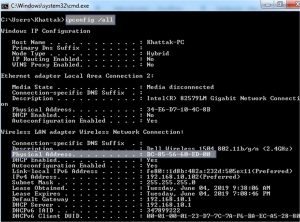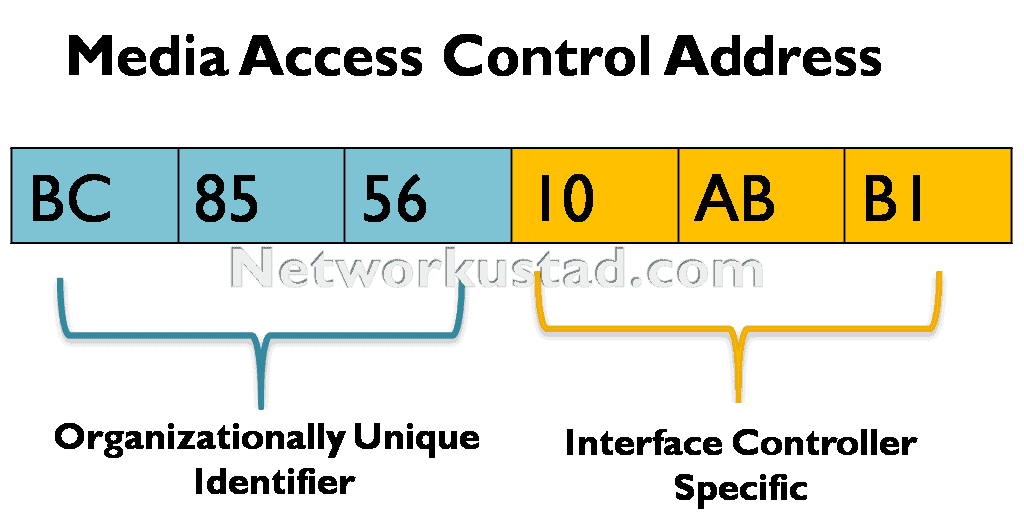MAC Address
A media access control address or a MAC address of a device is a worldwide unique identifier assigned to a network interface controller. It is also known as “hardware address” or “physical address” and very important for communication within network segments. Most IEEE 802 network technologies, including Ethernet, Wi-Fi, and also a Bluetooth uses Media Access Control address for within network segment communication.
It is a 48-bit binary value expressed as 12 hexadecimal digits. As we know that decimal is a base ten “(xxx)10” number system and Hexadecimal is a base sixteen “(xxx)16” number system. The base sixteen numbers system uses the number from 0 to 9 as well as letters from A to F. Where A= 10, B=11, C=12, D=13, E=14, and F=15.
Ethernet Identity
In Ethernet LAN, each network device connected to share media. Therefore all nodes would receive every frame transmitted over the shared media. So, to stop too much overhead involved in the processing of every frame, MAC addresses identify the actual source and destination. Media Access Control addressing also provides a method for device identification.
MAC Address Structure
Vendor Develop Ethernet Card and also assign it a unique address followed by IEEE standards. IEEE required registration of any organization with them that manufactures Ethernet Devices and NIC cards.
After registration, IEEE assigns a 3-byte code term Organizational Unique Identifier(OUI). So, each MAC Addresses assigned to an Ethernet device must have a vendor OUI and also a unique serial number assigned to them.
Media Access Control Addresses assigned to an Ethernet device must have a vendor OUI and a unique serial number assigned to them. Hardware and software manufacturers represent the Physical address or Media Access Control address in different hexadecimal formats that are 12 digits (6 byte or 48 bits), as shown in the following:
- MM:MM:MM:SS:SS:SS
- MM-MM-MM-SS-SS-SS
- MMM.MMM.SSS.SSS
The leftmost 6 digits (24 bits) called an “OUI” which associated with the adapter manufacturer. Every manufacturer registers and obtains MAC OUI as assigned by the IEEE. the manufacturer often possesses many OUI numbers associated with their different products.
The rightmost digits of a Media Access Control address represent an identification number for the particular device. Devices manufactured by the same vendor OUI, each is given their own unique 24-bit number. The figure below illustrates the Media Access Control Address. The figure below illustrates the Media Access Control address OUI as well as Interface controller-specific number.

IEEE requires a vendor to follow two simple rules:-
- MAC addresses assigned to a NIC and also to another Ethernet device must use that vendor’s assigned OUI as the first 3 bytes.
- All MAC addresses with the same OUI must be assigned a unique value in the last 3 bytes.
Note: Duplicate Media Access Control addresses are possible to exist due to mistakes during manufacturing or in some virtual machine implementation methods. In either case, it will be necessary to modify the MAC address with a new NIC or in software.
How to find MAC address for Personal Computer
On a Windows host, we can find the MAC address using the command “ipconfig /all” as shown in the figure below. This command identifies the MAC address of an Ethernet adapter. The steps for finding MAC address are the following:-
- Click Windows Start or press the Windows key.
- In the search box, type cmd, and press Enter
- The command prompt you should see now.
- Type ipconfig /all. and press Enter
- A Physical Address displays for each adapter. The Physical Address is your device’s MAC address.

Note:- We often see various representations of MAC addresses which depend on devices and operating system. Cisco routers and switches also use the address in the form of XXXX.XXXX.XXXX where X is a hexadecimal character.

